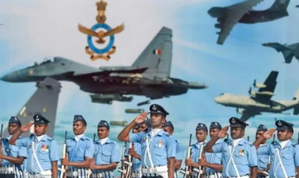New Delhi, Oct 7 (IANS) The Indian Air Force (IAF) is all set to celebrate its 92nd Raising Day on 8 October, honouring its rich legacy while reaffirming its commitment to strengthening operational capabilities and fostering national pride.
The commemoration began on October 6 and will conclude on October 8 in the southern city of Chennai.
Air Chief Marshal AP Singh will address the IAF officials while the Air Force Day parade and air display will also take place in Chennai.
Ministry of Defence said that the IAF stands as a crucial pillar of India’s defence strategy, embodying a rich legacy of bravery and innovation.
The ministry said that with its modernised fleet and advanced technological capabilities, the IAF plays a vital role in safeguarding the nation’s sovereignty and enhancing regional stability.
It added that through rigorous training, strategic partnerships, and a commitment to humanitarian missions, the IAF not only protects India’s skies but also fosters international cooperation.
“As it continues to evolve, the IAF remains dedicated to upholding its core values of integrity, service, and excellence in every endeavour,” the ministry said.
IAF was established on 8 October 1932, this momentous occasion marked the beginning of a vision for air power that would shape the nation’s defense for decades to come.
Just months later, on April 1, 1933, the IAF’s first operational flight took to the skies, manned by a small but determined group of six RAF-trained officers and 19 Havai Sepoys.
Between 1966 and 1971, the Indian Air Force (IAF) experienced a transformative period marked by modernisation and strategic expansion, driven largely by lessons learned from the Indo-Pakistan conflict. This era underscored the importance of not only having a capable and well-trained personnel base but also the critical need for advanced and effective equipment.
The evolution of IAF from the 1971 Indo-Pakistan War to the Kargil Conflict in 1999 highlights its significant growth and modernisation.
The ministry said that in the 1971 war, the IAF’s effective operations, with over 4,000 sorties and air superiority using Gnats and MiG-21s, marked its early strength. By the mid-1970s, the IAF modernised, introducing aircraft like the Jaguar and Mirage 2000, enhancing its capabilities.
During the 1999 Kargil Conflict, the IAF’s precision air support in Operation Safedsagar, especially in high-altitude terrain, underscored its ability to adapt to modern warfare.
The ministry added that air power played a vital role in minimising Indian casualties and neutralising enemy defences, with MiG and Mirage fleets excelling in challenging conditions. The successful use of modified helicopters like the Mi-17 further emphasised the IAF’s tactical flexibility.
The ministry said that post-1999, the IAF’s modernisation continued with the induction of the indigenous Tejas Light Combat Aircraft in 2016, designed for multi-role missions, featuring advanced avionics and manoeuvrability. This evolution reflects the IAF’s transformation into a formidable, technologically advanced force.
–IANS
gcb/dan






























